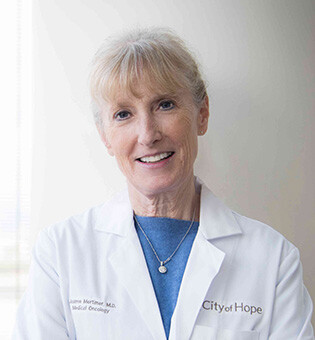
Dr. Joanne Mortimer, Medical Oncologist and Baum Family Professor in Women’s Cancers, has devoted her career to advancing breast cancer care and research. She was drawn to the field during her medical training in the 1970s and 1980s, a time shaped by the women’s liberation movement. “I’ve always been invested in women’s health,” she says. That commitment has guided her through more than 40 years of medicine, research, and advocacy.
The Changing Landscape of Breast Cancer Care
When Dr. Mortimer began her career, treatment for breast cancer was limited and often grueling. In the 1990s, a wave of new approaches transformed the field: taxanes like paclitaxel (Taxol), targeted therapies like trastuzumab (Herceptin), and refinements in hormonal therapies offered new hope to patients. These developments dramatically improved survival rates, especially when breast cancer is detected early.
Today, she notes, treatment continues to evolve, with new drugs and technologies being developed at a rapid pace. But despite these improvements, she stresses that the experience of a breast cancer diagnosis remains profoundly difficult. “Survival rates are higher than ever,” she says, “but that doesn’t take away from the horror of treatment,” or from the psychosocial impact of a cancer diagnosis.
For Dr. Mortimer, giving patients hope means being realistic. She explains that the truth—that the reality is survival is higher than it’s ever been—it gives patients hope. Being honest is what helps.
A System at Odds with Itself
Still, Dr. Mortimer is candid about the structural challenges that patients and providers face. Insurance companies don’t want people to get better because healthy people don’t make them money. She says, “You don’t get paid well to do quality survivorship.”
This creates a tension between the calling of physicians—to make patients well—and the incentives of healthcare systems. “We respond to illness by treating it, not by preventing it,” she notes, pointing out that quality primary care and routine preventive medicine are not realities for many. Insurance models reward acute treatment more than long-term wellness. “It’s frustrating because prevention should be where the investment is.”
Genetics and the Future of Care
One of the biggest shifts Dr. Mortimer has seen over her career is the growing appreciation of genetics. “People are more aware than ever of the genetic links to cancer,” she says. While inherited BRCA1 and BRCA2 mutations account for about 5–10% of all breast cancers, that percentage is still significant. Advances in genetic testing have made it possible to identify those at higher risk and intervene earlier.
She also emphasizes the importance of lifestyle choices, especially weight-bearing exercise, which supports bone health and can help reduce risk for recurrence in some patients.
The Power of the Team
When asked what she is most proud of, Dr. Mortimer doesn’t point to a single research breakthrough or publication, but rather to a philosophy of care. “What I’m most proud of is the way breast cancer is managed—as a team.” It’s not just one doctor. It’s surgeons, oncologists, radiologists, nurses, social workers—all of us together.
She also finds joy in working with inquisitive patients. “They make us better doctors” because patients who come in with lots of questions, who’ve done their own research, who push doctors to talk about every option. Those conversations not only make for better doctors, but also helps patients feel a sense of autonomy in their care.
Connection and Validation
Outside of the clinic, Dr. Mortimer points to the power of survivorship conferences and community gatherings. “These events are so amazing because the most important thing participants get out of them is validation. It makes you realize you are not alone.”
While social media has broadened the ways women with breast cancer connect, Dr. Mortimer notes that community is nothing new. “Women have always found ways to connect. Before, it was in neighborhoods and local groups. Now it might be online, but the drive to support one another has always been there.”
Men and Breast Cancer
Though breast cancer is most often associated with women, about 1 in 200 breast cancer patients is male. Dr. Mortimer has cared for both men and women with the disease throughout her career.
Do men feel isolated or stigmatized? Not necessarily, she says. “I haven’t seen men feel excluded by the breast cancer movement. In fact, many really embrace it.” They learn about how male breast cancer is different—how it’s caught differently—and many become advocates for men to get checked.
So, how do men get checked? Typically, diagnosis begins with physical exams and imaging—similar to women. Male breast cancer is often detected when a man or his doctor notices a lump behind the nipple or changes in the breast tissue. Awareness, Dr. Mortimer emphasizes, is key.
A Career of Commitment
Reflecting on her decades of work, Dr. Mortimer’s passion shines through. “I love what I do,” she says. For her, it’s not just about the science or the drugs—it’s about the people, the conversations, the validation, and the hope that honest, compassionate care can bring.
Her career is proof that progress in medicine is measured not only in survival rates and new therapies, but in the human connections that sustain patients and providers alike.
